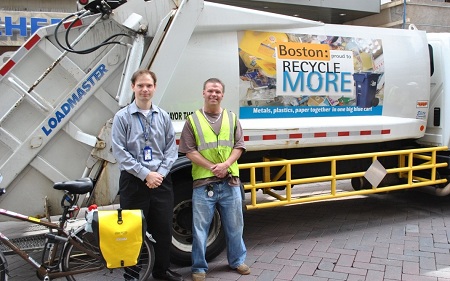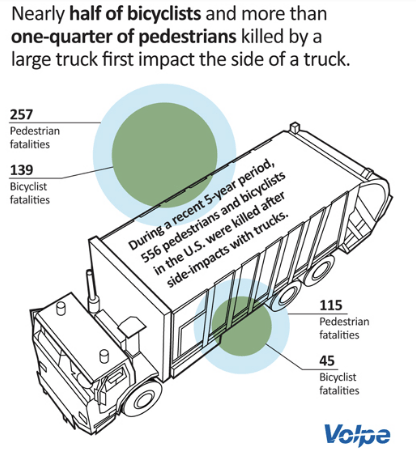Why American Trucks Are So Deadly for Pedestrians and Cyclists
3:23 PM EDT on October 31, 2016
Large trucks are a leading killer of cyclists and pedestrians in urban areas. While London has recently decided to kick the most dangerous trucks out of the city, in the U.S., truck safety regulations are much further behind.

Engineer Alex Epstein of the Volpe Center, a research arm of U.S. DOT, spent five years examining how truck design affects bike and pedestrian safety. As a government researcher, he's not authorized to discuss federal regulations, but his work is intended to guide policy.
We spoke with Epstein about what he's learned and the potential implications. The interview was lightly edited for length and clarity.
So what have you been learning?
We've been looking at the impact on bicycle and pedestrian safety, particularly in urban areas. The proportion of bicycle and pedestrian fatalities involving large trucks and the proportion of trucks on the road is not one-to-one.
Nationally it’s more like 3 to 1 -- three times as many bicyclists killed. So 11 percent of bicyclist [fatalities are accounted for] by the 4 percent of vehicles on the road [that] are trucks.
In cities, it’s more disproportionate. In New York City, about 32 percent -- about one out of every three cyclists that are killed -- are killed by a truck. And for pedestrians it’s about one in eight.
And you've been investigating some possible solutions?
Starting with some of the low hanging fruit, for example side guards as a mitigation.
Trucks by design have large blind spots, or really a set of blind spots. It means that the visibility in a truck is not as good as it is in an automobile. And then the vehicle is so high off the ground and has a large turning radius. When turning for example, they may be particularly hazardous. When pedestrians are out they might not be visible. And when collisions happen, they are deadly collisions.

There’s a study, in San Francisco, when a pedestrian was in a collision with a bus or truck, the chance of dying was eight times greater than the chance when one is hit by an automobile. And then in London, I believe they suggested they were 78 times more likely, but that was specifically for trucks. That is not good news.
We also saw [that] about one in two bicyclists killed [initially] hit the side of the truck, which is where people on bikes will fall under the trucks and be run over. We just had, unfortunately, a number of those types of crashes in the Boston area this summer.
That’s where side guards or side underride guards help, by keeping the person over the wheelpass of the moving truck.
We actually published a voluntary side guard standard [PDF] to bring a consistent specification to vendors or local areas that wish to use it. So that’s on our website and I feel like it’s really raised the level of awareness about that particular technology. But that’s the last line of defense when a collision is already happening.
There are many things upstream of that we’re looking at for crash avoidance, everything ranging from additional mirrors to increasingly sophisticated cameras and alert systems, to redesigning the truck cab itself to the kind of direct vision standards London is considering.
There’s not very much out there that governs the visibility that a driver has. In the European and U.S. context, truck cabs have not changed much in decades. They don’t provide a particularly good or complete field of view. While that’s problematic in a highway setting, it’s especially problematic in an urban setting where other road users are closer and there are far more turns.
I don’t know if you’ve ever sat in a truck cab. I’ve sat in quite a few for my research and it’s surprising how much you cannot see. A 6-foot-tall man or woman can stand directly in front of some of the larger trucks, particularly construction vehicles, and be invisible.
The federal government does regulate truck design just like they do with cars, right?
I can give you some broad brush strokes of what is and isn’t regulated. In general, I can cite a 2006 review by Dan Blower from the University of Michigan that did a review and found there is no federal requirement for direct vision. And generally there’s one requirement for mirrors, which is just a planar mirror. The reality is, most trucks out there have a lot more. There are truck models that provide better vision than others, which is why London is trying to differentiate them and give them a five-star rating. This becomes a metric on which fleet operators can buy them. That’s an issue that we need to look at, and that’s why we’ve been looking at it. The EPA has fuel economy ratings for cars. There’s not really a visibility rating for trucks.
One way that the cities that are taking on truck safety are going about it is using their power of procurement. And then that can become a metric for how they procure things.
What I heard is that Boston is the only city in the U.S. that’s doing that -- restricting its contracts to companies with trucks that have side guards.
Boston has the side guard and crossover mirror ordinance for its contractors. Washington, DC, is the first to take this on at the state level and in July passed a side guard law for all trucks registered [there], that was called the Bicycle and Pedestrian Safety Amendment Act. That’s a fairly momentous move.
That means trucks can’t drive into DC unless they have side guards and those special mirrors?
No. Similar to other state laws out there, similar to the New York State crossover mirror law, that only applies to in-state trucks -- in that case, in-state registered trucks that operate inside New York City. Trucks registered in New Jersey are not subject to that. Trucks registered in DC or Maryland could still drive through and not be subjected to that. Other states like Oregon and Washington have crossover mirror laws as well.
How have safety devices like this become mainstream historically. What would be the process for that?
The progressive players in the industry will adopt it first. They will say, "This will save lives. My company saves liability from lawsuits." And [there are] other types of things that they might be concerned with, like good citizenship. Those progressive early adopters then make it possible to standardize that through guidelines, policies, standards. Then there’s someone to work with.
That’s what Transport for London did. They launched a freight operator recognition scheme and then formalized it.
Angie Schmitt is the author of Right of Way: Race, Class and the Silent Epidemic of Pedestrian Deaths in America, and the former editor of Streetsblog USA.
Stay in touch
Sign up for our free newsletter
More from Streetsblog USA
Friday’s Headlines Are Down on Highways
Two outlets recently featured articles on the harmful effects of ongoing freeway projects.
Commentary: There is Zero Ambiguity to the West Portal Tragedy
What happened in West Portal was entirely predictable and preventable. The city must now close Ulloa to through traffic and make sure it can never happen again.
Talking Headways Podcast: Details of Development Reform in Minnesota, Part I
Jim Kumon of Electric Housing discusses his work as a developer and urban policy educator in the Twin Cities.
Thursday’s Headlines Don’t Like Riding on the Passenger Side
Can you take me to the store, and then the bank? I've got five dollars you can put in the tank.
Study: When Speed Limits Rise on Interstates, So Do Crash Hot Spots on Nearby Roads
Rising interstate speeds don't just make roads deadlier for people who drive on them — and local decision makers need to be prepared.




